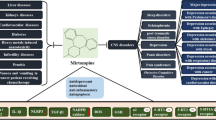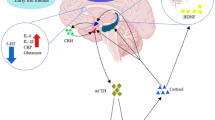Abstract
S100B protein is a calcium-binding protein mostly derived from glial cells, which exerts trophic or toxic effects on neural cell depending on its concentration. It has been reported that S100B played an important role as a potential marker in psychiatric disorders. Thus, we will explore the clinical implication of S100B in major depression, especially the effect of gender and numbers of depressive episodes on S100B. The levels of serum S100B were measured with enzyme-linked immunosorbent assay (ELISA) in 54 patients with major depression and 35 age-matched healthy controls. The S100B levels in major depressed patients were significantly higher than those in controls. The serum S100B levels in female patients were significantly higher than those in male patients. Patients with recurrent depressive episodes had significantly higher S100B levels than those in first-episode depression. Serum S100B levels were significantly positive related with the numbers of depressive episode, family history and cognitive disturbance scores. These findings confirmed an increase in serum S100B levels in major depressive patients and presence of a sexual dimorphism. Moreover, numbers of depressive episodes in depression seemed to have an additional increasing effect on S100B levels.

Similar content being viewed by others
References
Angst J, Hochstrasser B (1994) Recurrent brief depression: the Zurich study. J Clin Psychiatry 55(suppl):3–9
Angst J, Merikangas K (1997) The depressive spectrum: diagnostic clssification and course. J Affect Disord 45(1–2):31–39
Arolt V, Peters M, Rothermundt M (2002) Neuroplasticity in major depression may be indicated by S100B. Posters P32.02
Arolt V, Peters M, Erfurth A, Wiesmann M, Missler U, Rudolf S, Kirchner H, Rothermundt M (2003) S100B and response to treatment in major depression: a pilot study. Eur Neuropsychopharmacol 13(4):235–239
Bockting CL, Spinhoven P, Koeter MW, Wouters LF, Visser I, Schene AH, DELTA study group (2006) Differential predictors of response to preventive cognitive therapy in recurrent depression: a 2-year prospective study. Psychother Psychosom 75(4):229–236
Cotter D, Mackay D, Landau S, Kerwin R, Everll I (2001) Reduced glial cell density and neuronal size in the anterior cingulate cortex in majordepressive disorder. Arch Gen Psychiatry 58:545–553
Dietrich DE, Hauser U, Peters M, Zhang Y, Wiesmann M, Hasselmann M, Rudolf S, Jungling O, Kirchner H, Munte TF, Arolt V, Emrich HM, Johannes S, Rothermundt M (2004) Target evaluation processing and serum levels of nerve tissue protein S100B in patients with remitted major depression. Neurosci Lett 354(1):69–73
Donato RJ (1999) Functional roles of S 100 proteins, calcium-binding proteins of the EF-hand type. Biochem Biophys Acta 1450:191–231
Druse MJ, Gillespie RA, Tajuddin NF, Rich M (2007) S100B-mediated protection against the pro-apoptotic effects of ethanol on fetal rhombencephalic neurons. Brain Res 1150:46–54
Duman RS (2002) Pathophysiology of depression: the concept of synapticplasticity. Eur Psychiatry 17(Suppl 3):306–310
Duman RS, Malberg J, Nakagawa S, D’Sa C (2000) Neuronal plasticity and survival in mood disorders. Biol Psychiatry 48:732–739
Eriksen JL, Druse MJ (2001) Potential involvement of S100B in the protective effects of a serotonin-1a agonist on ethanol-treated astrocytes. Brain Res Dev Brain Res 128(2):157–164
Eriksen JL, Gillespie R, Druse MJ (2002) Effects of ethanol and 5-HT1A agonists on astroglial S100B. Brain Res Dev Brain Res 139(2):97–105
Gattaz WF, Lara DR, Elkis H, Portela LV, Goncalves CA, Tort AB, Henna J, Souza DO (2000) Decreased S100-beta protein in schizophrenia: preliminary evidence. Schizophr Res 43:91–95
Grabe HJ, Ahrens N, Rose HJ, Kessler C, Freyberger HJ (2001) Neurotrophic factor S100 beta in major depression. Neuropsychobiology 44:88–90
Hetzel G, Moeller O, Evers S, Erfurth A, Ponath G, Arolt V, Rothermundt M (2005) The astroglial protein S100B and visually evoked event-related potentials before and after antidepressant treatment. Psychopharmacology (Berl) 178(2–3):161–166
Izumi T, Iwamoto N, Kitaichi Y, Kato A, Inoue T, Koyama T (2007) Effects of co-administration of antidepressants and monoamine oxidase inhibitors on 5-HT-related behavior in rats. Eur J Pharmacol 565(1–3):105–112
Lara DR, Souza DO (2000) Schizophrenia: a purinergic hypothesis. Med Hypotheses 54(2):157–166
Lara DR, Gama CS, Belmonte-de-Abreu P, Portela LV, Goncalves CA, Fonseca M, Hauck S, Souza DO (2001a) Increased serum S100B protein in schizophrenia: a study in medication-free patients. J Psychiatr Res 35(1):11–14
Lara DR, Portela LVC, Goncalves CA, Souza DO (2001b) Glial cells and S100B in psychiatry (reply to Drs. Hari and Radmila Manev). J Psychiatr Res 35:349–350
Machado-Vieira R, Lara DR, Portela LV, Goncalves CA, Soares JC, Kapczinski F, Souza DO (2002) Elevated serum S100B protein in drug-free bipolar patients during first manic episode: a pilot study. Eur Neuropsychopharmacol 12(3):269–272
Manev R, Uz T, Manev H (2001) Fluoxetine increases the content of neurotrophic protein S100b in the rat hippocampus. Eur J Pharmacol 420:R1–R2
Mazure CM, Keita GP, Blehar MC (2002) Summit on women and depression: proceedings and recommendations. American Psychological Association, Washington
Meyer JH (2007) Imaging the serotonin transporter during major depressive disorder and antidepressant treatment. J Psychiatr Neurosci 32(2):86–102
Nishiyama H, Takemura M, Takeda T, Itohara S (2002) Normal development of serotonergic neurons in mice lacking S100B. Neurosci Lett 321(1–2):49–52
Nygaard O, Langbakk B, Romner B (1997) Age- and sex-related changes of S-100 protein concentrations in cerebrospinal fluid and serum in patients with no previous history of neurological disorder. Clin Chem 43(3):541–543
Ongur D, Drevets WC, Price JL (1998) Glial reduction in the subgenual prefrontal cortex in mood disorders. Proc Natl Acad Sci USA 95:13290–13295
Ostrovskaya RU, Gruden MA, Bobkova NA (2007) The nootropic and neuroprotective proline-containing dipeptide noopept restores spatial memory and increases immunoreactivity to amyloid in an Alzheimer’s disease model. J Psychopharmacol 21(6):611–619
Paradis AD, Reinherz HZ, Giaconia RM, Fitzmaurice G (2006) Major depression in the transition to adulthood: the impact of active and past depression on young adult functioning. J Nerv Ment Dis 194(5):318–323
Rajkowska G (2000) Postmortem studies in mood disorders indicate altered numbers of neurons and glial cells. Biol Psychiatry 48(8):766–777
Rothermundt M, Arolt V, Wiesmann M, Missler U, Peters M, Rudolf S, Kirchner H (2001a) S100B is increased in melancholic but not in non-melancholic major depression. J Affect Disord 66(1):89–93
Rothermundt M, Missler U, Arolt V, Peters M, Leadbeater J, Wiesmann M, Rudolf S, Wandinger KP, Kirchner H (2001b) Increased S100B blood levels in unmedicated and treated schizophrenic patients are correlated with negative symptomatology. Mol Psychiatry 6(4):445–449
Rothermundt M, Ponath G, Arolt V (2004) S100B in Schizophrenic Psychosis. Int Rev Neurobiol 59:445–470
Scaccianoce S, Del Bianco P, Pannitteri G, Passarelli F (2004) Relationship between stress and circulating levels of S100B protein. Brain Res 1004:208–211
Schroeter ML, Abdul-Khaliq H, Diefenbacher A, Diefenbacher A (2002) S100B is increased in mood disorders and may be reduced by antidepressive treatment. Neuroreport 13(13):1675–1678
Shashoua VE, Hesse GW, Moore BW (1984) Proteins of the brain extracellular fluid: evidence for release of S-100 protein. J Neurochem 42:1536–1541
Shoval G, Weizman A (2005) The possible role of neurotrophins in the pathogenesis and therapy of schizophrenia. Eur Neuropsychopharmacol 15(3):319–329
Tajuddin NF, Orrico LA, Eriksen JL, Druse MJ (2003) Effects of ethanol and ipsapirone on the development of midline raphe glial cells and astrocytes. Alcohol 29(3):157–164
Van Eldik LJ, Wainwright MS (2003) The Janus face of glial-derived S100B: beneficial and detrimental functions in the brain. Restor Neurol Neurosci 21(3–4):97–108
Van Eldik LJ, Ehrenfried B, Jensen RA (1984) Production and characterization of monoclonal antibodies with specificity for the S100 beta polypeptide of brain S100 fractions. Proc Natl Acad Sci USA 81:6034–6038
Whitaker-Azmitia PM, Azmitia EC (1994) Astroglial 5-HT1a receptors and S-100 beta in development and plasticity. Perspect Dev Neurobiol 2(3):233–238
Yang K, Xie GR, Hu YQ, Mao FQ (2008) Association study of astrocyte-derived protein S100B gene polymorphisms with major depressive disorder in Chinese individuals. Can J Psychiat (accepted)
Zhang MY (1993) The handbook of rating scale in psychiatry branch of study. Science and Technology Publishing Company in Hunan, Changsha, pp 81–127
Zhang YL (2007a) High-ranking psychiatry: the forth chapter-the causes and onset mechanism in mental disorders. Publishing Company in Central Southern University, Changsha, p 60
Zhang YL (2007b) High-ranking psychiatry: the forth chapter-the causes and onset mechanism in mental disorders. Publishing Company in Central Southern University, Changsha, pp 55–141
Acknowledgments
The authors are grateful to Dr. Jie Li (Department of Psychiatry, Tianjin Medical University) for helpful revising the manuscript. The authors thanked all doctors and nurses who participated in our study in the Second Xiangya Hospital of Central Southern University for technical assistance. Moreover, we appreciated all patients and normal controls in our study.
Author information
Authors and Affiliations
Corresponding author
Rights and permissions
About this article
Cite this article
Yang, K., Xie, GR., Hu, YQ. et al. The effects of gender and numbers of depressive episodes on serum S100B levels in patients with major depression. J Neural Transm 115, 1687–1694 (2008). https://doi.org/10.1007/s00702-008-0130-8
Received:
Accepted:
Published:
Issue Date:
DOI: https://doi.org/10.1007/s00702-008-0130-8




